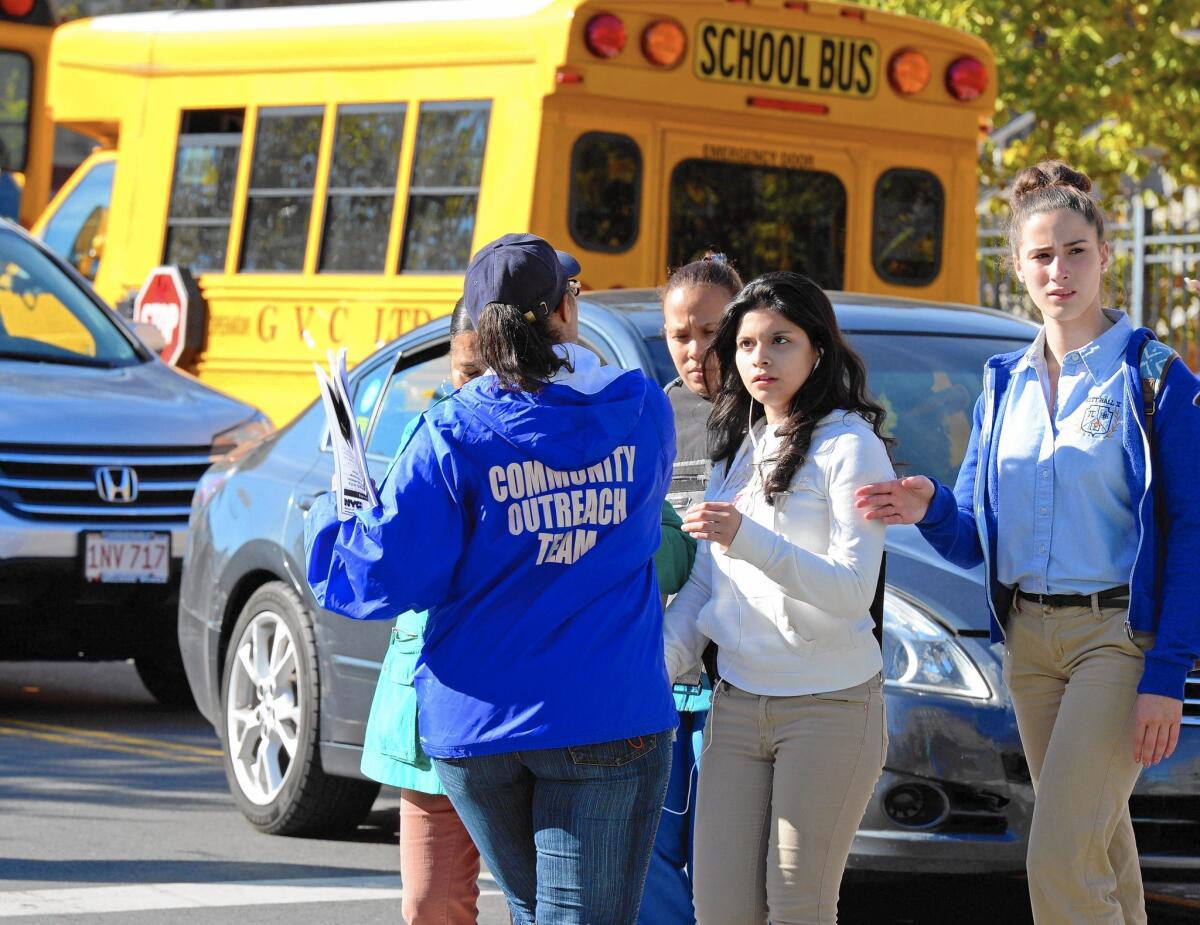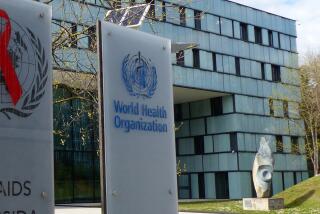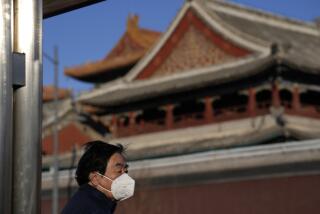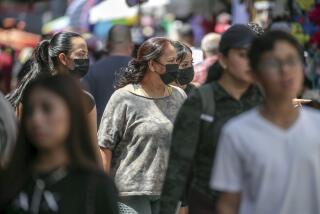Disorder among states’ Ebola strategies raises worries

- Share via
Reporting from NEW YORK — The federal Centers for Disease Control and Prevention issued new guidelines on dealing with travelers from Ebola-stricken regions Monday, but its lack of firm rules left a patchwork of state-by-state strategies that include mandatory quarantines for some travelers.
The different rules among states, and the CDC’s recommendation of looser monitoring than what is being carried out in several states, highlight what some public health experts said was the problem with the current system.
States not only have the leading role in devising policies to quarantine or isolate people with infectious diseases, they also control the enforcement, said Lawrence Gostin, a public health expert at Georgetown University.
“It’s a very ineffective way” to assure Americans’ safety in a public health emergency, he said. “We need to have much more uniformity in funding of local health departments. And we need to make sure procedures are standardized across states and the country. At the moment there’s just far too much variability.”
The new guidelines advise states to monitor travelers based on four levels of potential Ebola exposure, from high risk to no risk. They do not recommend 21-day Ebola quarantines for anyone who is symptom-free.
“We base our decisions on science and experience,” Dr. Thomas Frieden, director of the CDC, said during a news briefing.
He repeated the argument from quarantine opponents: that quarantines could lead airline passengers to conceal their travel histories and discourage medical workers from going to Africa to fight Ebola.
“If we turn them into pariahs instead of recognizing the heroic work they’re doing,” Frieden said, “they may be less likely to go and stop” Ebola at the source in Africa.
As he spoke, states were shifting and updating their existing standards for dealing with travelers from Guinea, Liberia and Sierra Leone — the three counties hit hardest by Ebola.
Maine, Minnesota and Georgia were among states announcing three-week quarantines for some travelers, including those who are not symptomatic. New York, New Jersey and Illinois already have such measures in place.
Pennsylvania, Florida and Virginia announced enhanced screening of travelers from West Africa, with some individuals subject to bans on the use of public transportation.
The CDC hoped to bring states into line behind its guidelines by recommending more aggressive monitoring of some travelers, and by recommending the banning from public transport of some people deemed at high risk of Ebola exposure.
But the new guidelines are not requirements.
“It goes back to federalism,” said Felice Batlan, a professor and associate dean for the Chicago-Kent College of Law.
“This is federalism on hormones, in that you have these multiple jurisdictions that all have the power to regulate,” Batlan said of various states’ approaches to Ebola.
Very few people are likely to fall into categories that would require them to be quarantined, no matter where they enter the United States.
Frieden said slightly fewer than 100 people daily arrived in the United States from West Africa. Of them, “5 or 6%” are healthcare workers who have cared for Ebola patients — the group most likely to be deemed at possible risk of exposure, he said.
According to the World Health Organization, 450 healthcare workers are known to have been infected with Ebola and 244 have died. The infected include Craig Spencer, a doctor who was hospitalized in New York on Thursday, six days after he returned from Guinea.
New York and New Jersey sparked the quarantine debate a day later when they declared that all returning healthcare workers who had treated Ebola patients would be quarantined for 21 days upon their arrivals.
A nurse who had been working in Sierra Leone, Kaci Hickox, became the first person quarantined, and her isolation in a tent in Newark, N.J., sparked a debate that drew in civil rights activists, public health specialists, politicians and the United Nations.
“We depend on them to fight this battle,” U.N. Secretary-General Ban Ki-moon said Monday. “Please do not quarantine them because they have volunteered to serve in the affected countries.”
New Jersey Gov. Chris Christie on Monday bowed to public pressure and released Hickox, who was never symptomatic, to return home to Maine. But in accordance with New Jersey’s rules, she remained under quarantine until she left — meaning she had to travel by private vehicle.
In Maine, she will be probably be quarantined in her home until 21 days after her last exposure to Ebola patients, according to regulations posted Monday on the state health department’s website.
The governors of New York and New Jersey have defended their actions, saying they are more concerned about public safety than about critics’ complaints that they are using draconian measures to allay fears of a virus that is far harder to spread than the flu or common cold.
The editor in chief of the New England Journal of Medicine, weighing in on the controversy Monday, said bluntly: “The governors have it wrong.”
“The governors’ action is like driving a carpet tack with a sledgehammer. It gets the job done but overall is more destructive than beneficial,” said the editorial written by Jeffrey M. Drazen and a team of Journal editors.
Trish Perl, a professor of medicine at Johns Hopkins University and senior epidemiologist for the Johns Hopkins health system, said quarantines were an important part of the public health system but a “tool of last resort.”
Such measures also lead to inconsistencies, such as the steps that would quarantine healthcare workers coming from West Africa but not those exposed to Ebola in U.S. hospitals, Perl said.
Healthcare workers treating Spencer in New York are not restricted from moving about the city, but they would be quarantined if they came back from treating patients in West Africa.
New York Gov. Andrew Cuomo, in defending quarantines, said if Spencer had been restricted from going out after he arrived in New York on Oct. 17, the city would have been spared having to track his movements and trace everyone he spent time with.
Perl, though, cited Spencer’s case as an example of how the system should work.
“He developed a fever, he notified authorities, they sent an ambulance equipped to handle a possible Ebola patient and he was brought to the right place. It was a textbook response,” she said. “We couldn’t have hoped for better.”
Times staff writers Matt Pearce, Monte Morin and Alexandra Zavis in Los Angeles and Noam N. Levey in Washington contributed to this report.
More to Read
Sign up for Essential California
The most important California stories and recommendations in your inbox every morning.
You may occasionally receive promotional content from the Los Angeles Times.












